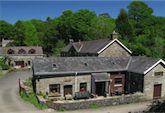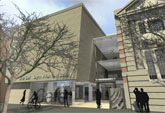”˜Salem’ is arguably the most famous Welsh painting of all time. The watercolour depicts a small Baptist Chapel near Llanbedr in Gwynedd, North Wales and shows an old lady in traditional dress, identified as Siân Owen, and other villagers at prayer. It was painted in 1908 by Sidney Curnow Vosper R.W.S. (1866-1942), the younger son of a Devonshire brewer.
Its fame may be partially attributed to the apparent appearance of the Devil in the folds of the shawl worn by Siân Owen. Legend tells us that she was so consumed with the sin of pride at being chosen as the centre-piece of the painting because of her colourful shawl, that the devil himself appeared in its cunningly contrived folds. His features may be picked out in the edge of the shawl over her left arm. Can you see his beard and horns?
Vosper’s intentions remain a mystery to this day. What is known is that he tried to create a pious Victorian atmosphere in a tranquil chapel scene, for posterity. The same Siân Owen features in Curnow Vosper’s painting ‘Market Day in Old Wales’, displayed at the National Museum of Wales in Cardiff. The dominant figure of the old lady in the shawl represents the ‘mother figure’ -so important in 19th Century Welsh family life. The quaint Welsh costume appears in both paintings.
Curnow Vosper studied Art in Paris under Raphael Collins and G. Courtois. Returning to London, he illustrated for various publications, but he continued with his watercolour studies, exhibiting at the Royal Academy in 1904, the Royal Institute, the Paris Salon, and at Liverpool, Manchester and other provincial art galleries. In 1902 he married Constance James of Merthyr Tydfil- thus the Welsh connection, and the works of this popular artist were soon in great demand. Rich connoisseurs of the arts immediately bought his exhibits as they became available and, having been exhibited at the Royal Academy in 1909, “Salem” was bought by Lord Leverhulme (Sunlight Soap) for 100 guineas (£105), and displayed in the Lady Lever Art Gallery, Port Sunlight, Bebington, Merseyside. Salem became popular when advertised in connection with “Sunlight Soap”.
Vosper continued to visit North Wales on painting expeditions, and the popular, generous, if eccentric figure, in knickerbockers and a colourful cravat was always a welcome visitor. He would cycle everywhere on his huge ”˜sit up and beg’ green bicycle, with painting materials strapped to the cross bar. As well as being a proficient cyclist, he was also a strong swimmer, and enjoyed the Welsh beaches on his excursions. His London address was 77 Bedford Gardens and this colourful, likeable character was a member of the Chelsea Arts Club. He died at Sheldon, Devon, in 1942, when his son was a prisoner of war in the Middle East.
Today, Salem chapel is possibly Wales’s most famous place of worship, whilst S.C.Vosper’s painting has become a Welsh icon, just as Constable’s “Haywain” has become an English icon. It is a subject that has succeeded in touching the hearts of generations of Welsh people, because it is a symbol of Welshness.

